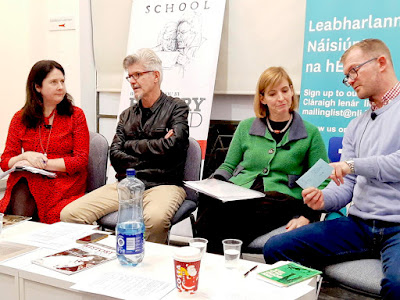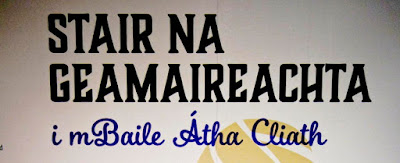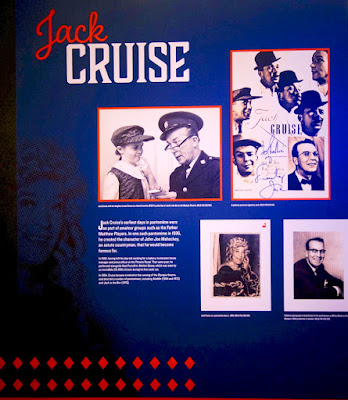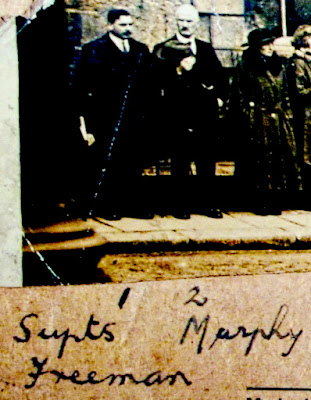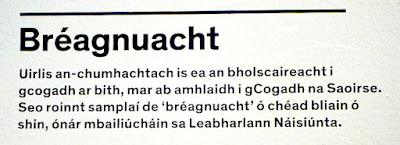As far as I know this is an unusual setting for a Hedge School. They've been held in the National Library's HQ in Kildare St., but this is the Library's National Photo Archive in Temple Bar.
At this time, it is a wholly appropriate location as the School's theme is An inconvenient truth? Sexual violence and the Irish Revolution while the current exhibition in the Archive is From Terror to Truce, a stunning visual chronicle of the brutality of the War of Independence 1919-21.
The Gods were clearly smiling on us on the night, as, due to a farmers' protest, Kildare St. was closed off by the Garda and its not clear if our tickets for the event would have got us through the cordon.
As usual Tommy's line up was impressive. Each of the panel had their own relevant area of expertise and they were all old hands at effectively participating in discussion.
Tommy is the Master and lays down the rules. He is also editor of the excellent periodical History Ireland which he reminded us was on sale at a discount at the back.
Having recently bought a full price copy in the local shop, I was tempted to ask for a refund, but I let it pass.
The Hedge School format is interesting. It is a variation on the usual panel presentation where each panelist would do a presentation followed by an individual or a general Q&A.
In Tommy's version there is interaction from the word go as he quizzes and cross-quizzes the contributors on their "homework" and invites audience participation from the outset.
Linda has been studying sexual violence against women for many years now. She acknowledged the increasing availability of sources, such as the BMH Witness Statements and the Military Pensions records, but, surprisingly, said that there were still other archives that she was campaigning to have opened.
As Tommy kept reminding us, she has an extensive article in the current issue of History Ireland, under the same title as this session, which covers sexual violence against women in both the War of Independence and the Civil War and the reaction of the authorities at the time.
There is that same tension that we see today between justice for victims and protecting the good name of the institution concerned.
It is not possible, at this stage, to determine the full extent of the sexual violence involved in these two conflicts, but what is known is horrific and the victims, often as not, have ended up in psychiatric institutions, reminding us that the lasting damage to victims is more mental/emotional than physical.
And there are also consequences for the perpetrators. Sometimes, though rarely, these have involved formal reaction by the authorities, but only when they were pushed into it, and it usually didn't lead to much, on the surface at least.
But it is probably fair to assume that there were eventual psychological effects for the perpetrators, though perhaps not as severe as those suffered by members of the Squad as a result of their performance on Bloody Sunday and subsequently in Oriel House.
Much of this has to be speculative as the majority of sexual attacks will have gone unreported or perhaps have just been known locally. The culture of shame of the time means that we will never know the full extent of this though bits and scraps will continue to surface.
Sometimes information lurks where you're not expecting it. Lindsey was not chasing up the revolutionary period as such. She was researching diocesan records for a study on poverty.
Suddenly, in the middle of the correspondence of the Archbishop of Dublin, she found a begging letter from Mary M who had been raped, became pregnant, and handed her baby son over to a Catholic rescue agency for adoption.
She lived in Moate, Co. Westmeath, and the agency were now telling her that she needed to pay twenty pounds to have her son adopted. Failing this he would be returned to her in Moate. Were this to happen her secret would be out and she'd be shamed locally. So she was asking the Archbishop for help. The Archbishop was sympathetic and send her a large sum of money.
The point, in the current context, is that this case did not turn up in the military archives and, had Lindsey not stumbled across it, it would not have come to light in the context of revolutionary sexual violence.
You can see the connection to revolutionary sexual violence, in Mary's own account of what happened, in her letter to the Archbishop.
During the Political trouble when looting and robbing & raiding were carried on to such an extent in our country district my trouble began. In January 1923 a party of men armed to the teeth & calling themselves Republicans forced their entrance into our house where in three people resided. My Aunt who is totally blind and is over 70 years, my Uncle 70 and I their neice an orphan. The object of their visit was money or lives. When I strove to save my Aunt from being dragged from her bed and they were furious when they did not get money one brute satisfied his duty passion on me. I was then in a dangerous state of health and thro’ his conduct I became Pregnant. Oh God could any pen describe what I have gone thro’.
Source
Brian has studied this period in great depth and he brought the wider context into the discussion.
My own view is that there is still some way to go in fully understanding the period and accepting it as it was, warts and all, in contrast to the almost blanket silence that descended, in my schooldays, on anything after the Glorious Rising of 1916.
History of the War of Independence subsequently tended to become local or familial, until prodded back into national consciousness by events, the 1966 commemorations being significant in this regard.
There are some difficult issues coming up over then next few years as we commemorate, inter alia, the violence of the War of Independence and the Civil War.
The picture above is on the cover of the current issue of History Ireland and it is not without its own history. Tommy told us that it went through many toning down iterations following a series of focus meetings among the periodical's staff.
In a totally separate vein, I should mention that Tom Clonan had been billed as a fourth member of the panel but was unable to attend. When looking him up I was glad to see he was caught up in a reconciliation with the defence forces who had treated him so badly many years ago over his exposing the mistreatment of women in their ranks.
If you haven't yet been, do make a point of visiting the brilliant exhibition on the premises. It may go some way in preparing you for the roller-coaster ride ahead.

